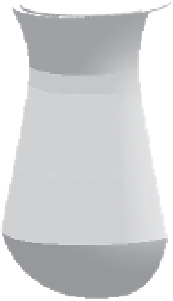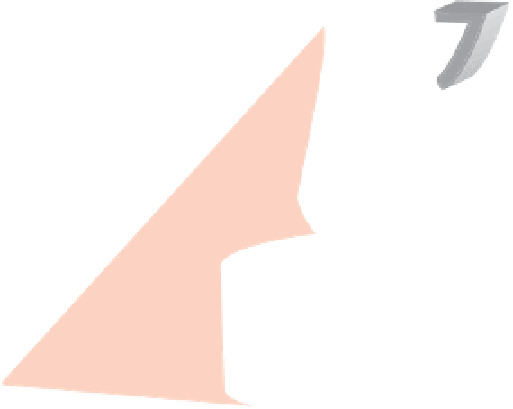Graphics Reference
In-Depth Information
Light stripe
projector
Camera
Figure 8.10.
The principle of structured light scanning. The object is illuminated with a plane
of light that intersects the surface of the object as a deformed stripe, which is observed by an
offset camera. The projector and camera are accurately calibrated so that 3D locations can be
recovered by triangulation.
aging transformations, or to provide a starting point for morphing into a computer-
generated creature.
The basic principle of structured light scanning is illustrated in Figure
8.10
. The
object to be scanned is illuminated with a vertical plane of light that intersects the
surface of the object as a deformed
stripe
. This light plane can be created with a
visible-spectrum laser that passes through a cylindrical lens, a slide projector, or an
off-the-shelf LCD or DLP projector.
The stripe has kinks where the surface normal changes, and discontinuities where
it falls on two physically separated surfaces. The stripe is observed from a nearby
camera that has been accurately calibratedwith respect to the projector; the camera's
image of the stripe allows us to reconstruct its 3D profile using triangulation. Often,
the camera is fitted with a special lens, filter, or polarizer to attenuate interference
from ambient light conditions and accentuate the color of the laser stripe.
Sweeping the light plane across the object allows its entire surface to be digitized.
A well-calibrated structured light system is extremely accurate, with errors of less
than a millimeter for tabletop-scanning scenarios. Structured light scans obtained as
an object is rotated in front of a fixed projector-camera system can be registered and
fused into a complete 360
◦
model of an object.
We first describe how to calibrate a structured light system consisting of a projec-
tor and a camera, and how to use triangulation to obtain accurate 3Dmeasurements
(Section
8.2.1
). We then extend the single-stripe approach to
time-multiplexing
methods, inwhichmultiple stripe patterns are projected onto a static object to obtain
a scan much more quickly than sweeping the stripe across the object (Section
8.2.2
).
We next explore
color stripe coding
methods, in which a more complex projected
pattern of light effectively casts multiple finely spaced stripes on the surface at



































































































































